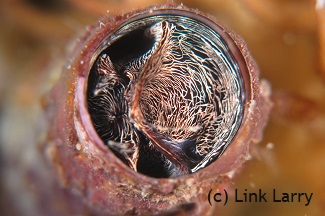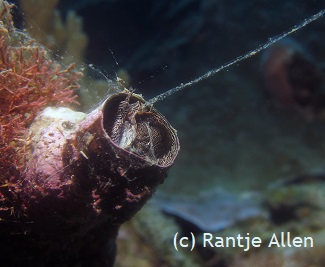Loading content - please wait...
Thylacodes grandis captures plankton in its net
Thylacodes grandis, or the Grand Worm Sail, uses mucous like a net to capture plankton. Its beautiful batik-patterned head is unmistakable.
Grand Worm Snails in the Reef
Worm snails are a family of marine molluscs. They live in long tubes rather than the usual coiled chambers of other snails. Worm snail tubes are irregular. Grand worm snails in Gorontalo measure about seven to ten centimeters in height. A worm snail will grow its tube from a hard substrate on the reef. Sometimes, a Grand worm snail will live separated from other marine life. More often, it will grow up among various corals with only its head above. Since these worm snails are long lived, hard corals can grow on the tubes.
Grand worm snails live in all Gorontalo’s coral dive sites. However, divers can easily overlook them. Most distinctive about this species is its lack of a cap. Also known as an operculum, the cap shuts the tube from the top, thus protecting the worm snail inside. Because it lacks this cap, the Grand worm snail’s head is exposed for divers to see. It has a distinctive maze of white to golden lines over a dark background. This background can be black to deep maroon. It resembles batik. Also apparent are the creature’s fleshy horns. When a diver approaches, the Grand worm snail will duck its head down into its tube.
Fishing with Mucous
Worm snails gather food by producing mucous steams. Their gills create a slight current. This current sends plankton
, that floats in the water column, into its sticky mucous. A careful diver can watch as the Grand worm snail rotates its head and draws its mucous net into its mouth.An easy way to search for worm snails in Gorontalo is simply to look for the mucous strands floating above the reef. The most common worm snail here is Dendropoma maxima. It grows from inside massive coral heads, often in groups. Since this species has a dark cap, divers can easily distinguish it from Thylacodes grandis. Grand worm snails in Gorontalo typically live below fifteen meters.
Thylacodes grandis and other names
Some older resources give the scientific name as Serpulorbis grandis. This is not an accepted name. Vermetus grandis is another unaccepted name associated with the Grand worm snail. Taxonomic work done in 2005 and 2006 has yet to be harmonized. However, there are over forty confirmed species in the Thylocodes genus. These include two new species, one in 2017 and another in 2018. The most beautiful and photogenic worm snail in Gorontalo is indeed Thylacodes grandis.
To see a Grand worm snail in action, please make your dive reservations directly with Miguel’s Diving.








Sorry, comments are closed for this post.